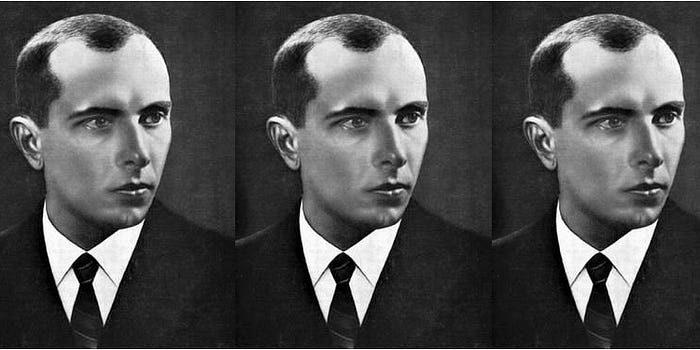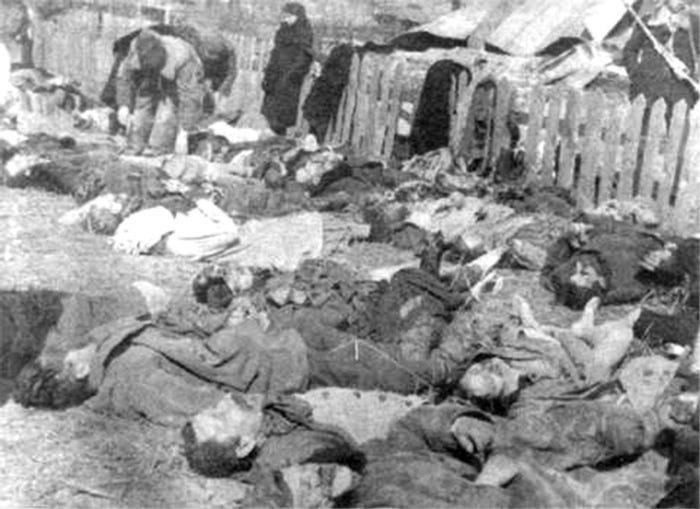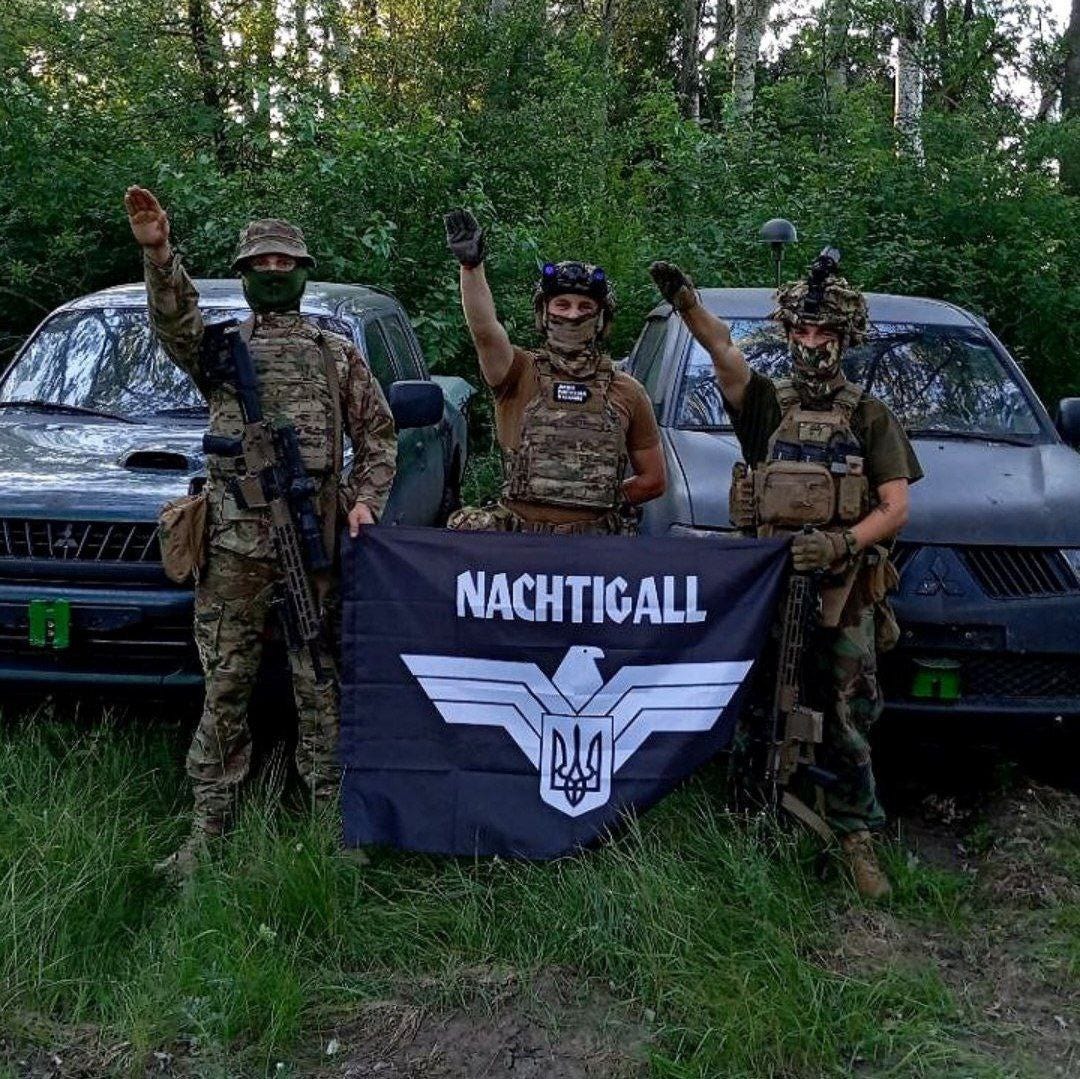The CIA and the Banderite Nazis
Ukrainian Nazis were spared from trial and punishment so they could serve the CIA and other Western intelligence services.
In the early years of the Cold War, prisoner swaps between the US and the Soviet Union were a regular occurrence. The events that unfold in the film “Bridge of Spies” actually happened, whenever one side wanted to get someone back from the other side.
And each side had people that they repeatedly asked to trade, but which the other side refused to let go.
Thomas Boghardt, a senior historian at the U.S. Army Center of Military History, relates the following story:
On 8 June 1946, Special Agent Robert R. Reeder, Jr., and Special Agent Stephen C. Rostan of the US Army Counter Intelligence Corps (CIC) met with two Soviet intelligence officers on Berlin’s Alexanderplatz. The CIC had requested the meeting to solicit Soviet assistance in apprehending Fred Kaltenbach, an American wanted for treason. A propagandist for Nazi Germany during the war, Kaltenbach was rumored to be hiding in the Soviet zone. Handing the Americans a list of “Russian traitors” residing in the US zone, the Soviets suggested a swap. Pointing to the name at the top, one of the Soviets said emphatically: “This man is for us as Kaltenbach is for you.”
By “this man”, the Soviets meant Stepan Bandera.

Operation ANYFACE
In his article, “Operation ANYFACE: How the US Army Shielded a Ukrainian Nationalist from Soviet Intelligence”, Boghardt explains:
The Americans delivered scores of war crimes suspects to the Soviets, but when it came to Bandera, the CIC balked. As the Soviets lodged request after request for the extradition of Bandera, the Corps feigned ignorance of his whereabouts. The CIC codenamed this deception effort Operation ANYFACE — after an elusive Dick Tracy character who could change his appearance at will.
Indeed, the US shielded Bandera and allowed him a comfortable life in West Germany — right up until he was finally assassinated by the KGB in 1959.
Stepan Bandera — Ukraine’s “National Hero”
Stepan Bandera was born in Lemberg, the capital city of what was then known as Austrian Galicia, on January 1, 1909. That city was later renamed Lviv after the fall of the Austro-Hungarian Empire following WWI.
During WWI, the Catholic Austrian Galicians in Lemberg were recruited by the Austro Hungarian Empire to persecute ethnic Russians in the Ukrainian territory. In fact, the very first “concentration camp” ever built in Europe was erected by the Austrians at Talerhof and was used to imprison ethnic Orthodox Russians rounded up by the Catholic Galicians who had been conscripted by the Austrians to do this “ethnic cleansing”.
Growing up in this environment inculcated in Stepan a deep hatred of Russians, whom he came to see as the Great Oppressor of his people, namely the Catholic Galicians — a people who also claimed to be the rightful and true Ukrainians.
Bandera’s father was a Catholic priest, which may have also influenced him to hate Orthodox Russians. In any case, Bandera joined the Organisation of Ukrainian Nationalists or OUN, at an early age (20) and quickly became known as a violent radical who took charge of the OUN in 1931.
Bandera was also head of the Ukrainian Insurgent Army (UPA), the military wing of the OUN-B (“B” for “Bandera”), which carried out all manner of atrocities against Poles, Jews and Russians while working with the Nazis.
Under the militant leadership of Stepan Bandera in World War II, the ultra-nationalists organised the Ukrainian Waffen SS Division, “1st Galician”, which included the Nachtigall Battalion, and Roland Battalion that collaborated with the Nazis and were responsible for the genocide of over 500,000 people.
Following the war, however, Ukrainian Nazis were one of the only Nazi groups to escape trial at Nuremberg for crimes against humanity.
The Americans wanted to “spare” the Ukrainian nationalists so they could use them in the emerging Cold War against the Soviet Union.
Moreover, neither the Banderites, the Ukrainian Waffen SS, nor any other Ukrainian collaborators have ever apologised for their participation in genocide.

The Ukrainian Supreme Council of Liberation (UHVR)
The OUN-B and UPA came together to form the Ukrainian Supreme Council of Liberation (UHVR in Ukrainian) toward the end of WWII. According to the Encyclopedia of Ukraine, the UHVR saw the USSR as their enemy.
In Soviet-occupied Ukraine the UHVR co-ordinated armed resistance through the UPA and waged a political and propaganda campaign against the Soviet authorities through the OUN. It also aimed its propaganda at Red Army detachments in Western Ukraine.
The group also knew whom they could approach for support in fighting their “war of liberation” against the Soviets. According to a declassified CIA document:
“In July 1944, before the Soviets took Lwów [Lviv], the UHVR sent a delegation of its senior officials to establish contact with the Vatican and Western governments. The delegation was known as the Foreign Representation of the Supreme Ukrainian Liberation Council (ZP/UHVR). It included Father Ivan Hrinioch as president of the ZP/UHVR; Mykola Lebed [founder of the UPA] as its Foreign Minister; and Yuri Lopatinski as the UPA delegate. […] Until 1948, all three envoys were members of the OUN/B party and loyal to Bandera.
The OUN-CIA Connection
The CIA, which was formed in 1947, has always maintained strong ties with the OUN-B and UPA holdouts (as well as Bandera himself) with an eye toward leveraging the groups’ violent anti-Russian orientation (“the enemy of my enemy…”).
A recently declassified CIA document (PDF) reveals:
OPC and OSO “agree[d] that the Ukrainian organization [Ukrainian Supreme Council of Liberation], the governing body of the OUN, offers unusual opportunities for penetration of the USSR, and assisting in the development of underground movements behind the Iron Curtain.”
The CIA — along with their sister organisation, MI6 — worked with Bandera’s UHVR after the war to form a cover organisation for their activities, called the Anti-Communist Bloc of Nations (ABN). As Thierry Meyssan notes:
The headquarters of the ABN was in Munich, from where Stepan Bandera and [his deputy] Yaroslav Stetsko conducted sabotage operations in the USSR. The chairman of the ABN was Ole Bjørn Kraft, the Danish former chairman of the North Atlantic Council (the civilian authority that commanded the Allied forces). Several operations were planned in collaboration with the CIA and MI6, i.e. under the supervision of Frank Wisner (Nicolas Sarkozy’s grandfather by marriage) and Kim Philby.
It is probably no coincidence, then, that the various international cohorts of the Ukrainian Nationalist Youth groups such as PLAST, CYM and others all seemed to be founded around 1948–49. They were prpbably founded with the help of the newly-minted CIA.
The Ukrainian nationalists and OUN-UPA hangers-on sold themselves to the CIA and the greater West as staunch anti-Communist organisations, whose “heroes” were not Nazi collaborators but anti-Soviet “freedom fighters”.
1949: Operation Red Sox
The CIA operation to utilise Ukrainian nationalists against the USSR started in 1949 and continued up until 1990. During this time, the mission was modified and renamed, but it was always aimed at the USSR, and relied on the anti-Russian sentiments of Banderite Ukrainian nationalists who were fanatically anti-Russian — both in Ukraine and in exile.
The original Project is described in a declassified CIA file from 1950.

The first of the Project’s many iterations was Operation Red Sox, and it was modelled after the old OSS methods of parachuting operatives into enemy territory.
Operation Red Sox, as it was known, was one of the first covert missions of the still new Cold War. The American-trained [Ukrainian] commandos would feed intelligence back to their handlers using new radio and communications equipment, stoking nascent nationalist movements in Ukraine, Belarus, Poland and the Baltics. The goal was to provide the U.S. unprecedented insight into Moscow’s designs in Eastern Europe — and, if possible, to help crack apart the Soviet empire itself.
1967: Operation Aerodynamics
As time went on, the CIA Ukrainian operation became less “kinetic” and more oriented towards propaganda. By the mid-1950s when the OUN-UPA forces in Ukraine had been mainly eliminated by Soviet intelligence, the Americans changed gears and concentrated on ideology and propaganda.
This was when they launched Project Aerodynamics to “exploit the anti-Soviet Ukrainian resistance groups in Western Europe for intelligence purposes”.
As detailed in declassified documents, the CIA worked with the UHVR to publish anti-communist literature and magazines, as well as conduct underground radio translation and support illegal Ukrainian political movements.
Aerodynamics had two goals: to encourage new and existing “anti-Soviet, anti-communist, Ukrainian nationalist sentiments” and to collect intelligence about “Soviet Ukraine and the USSR as a whole to meet US needs.”
1970: Operation QRPLUMB
Aerodynamic became Operation QRPLUMB in 1970. This operation set up the Prolog Research Center and became a sort of CIA clearinghouse for all clandestine activities and media propaganda in Ukraine.
Even though the “official” anti-Soviet operation was suspended following the fall of the USSR, the US transitioned the operation to a private enterprise in order to keep the anti-Russian propaganda machine “in business”:
“CIA terminated QRPLUMB after the fall of the Berlin Wall in 1991 and provided funds to enable Prolog to transition to a privately-funded company. In 1992, Prolog’s monthly Ukrainian journal Suchasnist (Contemporary Times) was successfully transitioned to a publishing company in Kiev, Ukraine and thereafter was published as a collaborative effort between Prolog and a Ukrainian group in Kiev.”
1991: The National Endowment for Democracy takes over
After the fall of the Soviet Union and the establishment of an independent Ukraine, the CIA handed off its anti-Russian operations to its cut-out organisation, the National Endowment for Democracy (NED). As observers and analysts know, NED is a “cut-out” of the CIA.
NED was founded in November 1983 by then-CIA director William Casey, who wanted to set up a public mechanism to support opposition groups, activist movements and media outlets in targeted countries and areas overseas.
The CIA itself was under heavy scrutiny and criticism at the time due to the “Dirty Wars” the Reagan Administration was waging “covertly” in Central America. Casey perceived the need for a “non governmental” agency to carry out CIA’s mission — away from prying eyes, under the cover of humanitarian legitimacy.
Officially a non-partisan, not-for-profit organisation, NED receives most of its funding from US taxpayers through legislation of the US Congress. It‘s budget comes from the US Agency for International Development (USAID) with the Department of State, and it is supposed to be subject to congressional overview.
The organisation was promoted by Ronald Reagan as a way “to foster the infrastructure of democracy”.
VIDEO:
Specifically, NED would engage in propaganda and political activism to disrupt, destabilise, and ultimately displace “enemy” regimes.
Underlining the Endowment’s insidious true nature, in a 1991 Washington Post article boasting of its prowess in overthrowing Communism in Eastern Europe, senior NED official Allen Weinstein acknowledged, “a lot of what we do today was done covertly 25 years ago by the CIA.”
In one year alone, NED funded 65 projects in Ukraine, for over $20 million. In all, the US has spent over $5 billion since 1991 funding “democracy” and “civil society” programs in Ukraine, according to Victoria Nuland. Much if not most of that money went to propaganda groups like NED.
2004: The Orange Revolution
It is no secret that the CIA (operating through NED) and the US State Department and other pro-Western “NGOs” have been fomenting so-called “colour revolutions” all over the world.
Ukraine’s colour was orange.
The US-led Orange Revolution was years in the making — NED and the other groups set up organisations and movements in Ukraine to promote “Western values” and above all, to alienate Russia. For this, of course, they relied heavily on the Ukrainian nationalist groups the CIA had been cultivating and finding since the end of WWII.
Banderite Nazism of course played a big role in these efforts. The Bandera followers had not been idle — they had whole histories and narratives written and ready to go. Ukrainian nationalists living in the USA and especially Canada had been cultivating, nourishing and growing the Banderite cult among their countrymen for decades.
Now, they thought, was their time.
These nationalist narratives were instrumental in galvanising the Ukrainian population to protest in 2004 and elect a pro-Western, anti-Russian President, Viktor Yushchenko.
The Guardian described the US efforts:
But while the gains of the orange-bedecked “chestnut revolution” are Ukraine’s, the campaign is an American creation, a sophisticated and brilliantly conceived exercise in western branding and mass marketing that, in four countries in four years, has been used to try to salvage rigged elections and topple unsavoury regimes.
Banderite National Heroes
Following the Orange Revolution that brought him to power, Yushchenko wasted no time in following through on his pro-Western promises — not just to the US, but to the Banderite nationalists.
One of those promises was to elevate Stepan Bandera to an official national hero.
In a nod to his nationalist backers, Yushchenko named Bandera and his OUN-UPA deputy, Roman Shukhevych “Heroes of Ukraine”.
Shukhevych was particularly problematic, as he had actually commanded the UPA Nachtigall Battalion, which slaughtered 100,000 Poles in 1943–44 on behalf of the Nazis.
Such provocative moves did not sit well with the majority of Ukrainians, who still saw the Banderites as criminals, and eventually the Orange Revolution overreached, and Yushchenko was defeated in his reelection bid, to be replaced by the more “Russia-friendly” Viktor Yanukovych.
Yanukovych immediately rescinded the “hero” status of Bandera and Shukhevych.
2014: The Maidan Coup
In September 2013, as Victoria Nuland and her cabal were at the height of their Maidan Coup planning, Carl Gershman, the President of NED who also helped found the NGO with Casey, wrote in the Washington Post:
“Ukraine is the biggest prize. The opportunities are considerable, and there are important ways Washington could help. The United States needs to engage with the governments and with civil society in Ukraine, Georgia and Moldova to ensure that the reform process underway not only promotes greater trade and development but also produces governments that are less corrupt and more accountable to their societies. An association agreement with the European Union should be seen not as an end in itself but as a starting point that makes possible deeper reforms and more genuine democracy”.
The NED operatives set about trying again.
Video: Ukraine’s Lessons Learned: From the Orange Revolution to the Euromaidan
Although their chosen President from 2004 had eventually failed, the Western powers and their Banderite allies had succeeded in changing Ukrainian civil society, and they also managed to make radical changes to the Ukrainian national identity.
Changing Ukraine’s “National Memory”
Under the Yushchenko administration, the Institute of National Memory (UNIP) was tasked with writing new textbooks on Ukrainian history “in order to help bring up the younger generation in a spirit recognising their national identity, respect and love for their native land”. The UNIP also launched all sorts of other programs to “De-Russify” Ukraine and to otherwise spread the ultranationalist message of Bandera’s OUN-B.
Thus, over the space of a decade, NED and their nationalist allies were able to transform a socialist, mostly Russian-friendly country into one that was ruled by distinctly fascistic, anti-Russian governmental institutions.
The US government was now ready to try another take-over, and this time the Americans were leaving nothing to chance.
As the Maidan Coup took shape, the Brookings Institute crowed:
“Ukraine has a rare second chance after the missed opportunity of the 2004 Orange Revolution to put itself on a course to becoming a modern European country, just as neighbouring Poland has done”.
That second chance had to be imposed by force, through a violent coup d’état, but the West was finally getting what it wanted — even if they had to kill democracy in Ukraine to get it.
An 80 year long investment finally “pays off”
When those representatives of the Organisation of Ukrainian Nationalists went to Rome to meet with Western officials in 1944, they no doubt expected to be welcomed; they probably even expected generous financial and logistical support for their “liberation struggle” against the Soviets.
What they most likely did not foresee, however, was that they were embarking on a long term strategic relationship that would go on for many decades.
Let us be clear: Bandera’s OUN still exists.
Outside of Ukraine, the OUN-B is even more active. Canada and the US are filled with monuments to Stepan Bandera, and OUN-aligned Ukrainian diaspora groups are highly active in reanimating the Bandera philosophy in modern-day Ukraine.
These organisations are all funded by the NED and other entities.

The CIA’s Operation Aerodynamic, with its concentration on anti-Russian media propaganda, is today STILL operating under various other names as part of the NED’s activities.
And it is not just the Ukrainians who are being brainwashed.
The entire collective West has been brainwashed to support Banderite Nazis and hate Russians.









